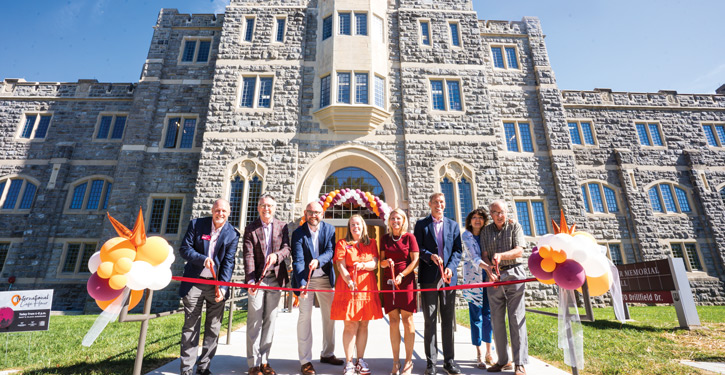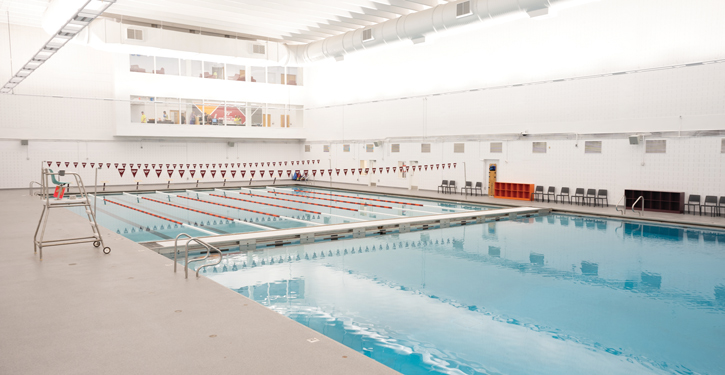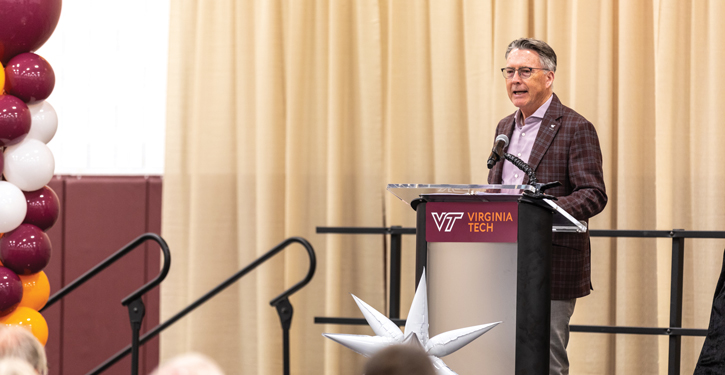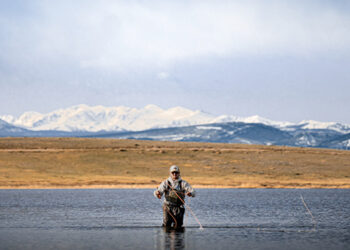War Memorial Hall was erected on Virginia Tech’s campus in 1925. Named in memory of the alumni who served in the first World War, it’s been a cornerstone at the center of university life for nearly 100 years.
It underwent its first big change in 1976 when it was expanded to offer more fitness space for students. As War Memorial saw the turn of the century, conversations began about another renovation. “We had no HVAC, a lot of big corridor spaces and we had 20-plus racquetball courts,” said Kyle LeDuc, the associate director of Facility Operations. “It wasn’t serving our students in the way a recreation facility serves students in 2016 when all this planning started.”
The decision was made to renovate War Memorial, and the Recreational Sports staff began to move out of the building in late 2019. Then came the spring of 2020. The COVID-19 pandemic put the renovation on hold and left War Memorial sitting empty. As such, the main recreation space on campus was the 180,000-square-foot McComas Hall. It had been built to supplement the recreational and educational needs of Virginia Tech, but it became the main hub.
The pandemic resulted in funding changes and thus numerous redesigns for the War Memorial project. Finally, LeDuc said construction fencing went up and they broke ground October 2022. It’s grand reopening was September 6, 2024.
War Memorial’s Renovation
Since then, the Recreational Sports team has seen an electric atmosphere on campus surrounding the newly renovated facility. “We’re very excited,” said Matt Lattis, the associate director for Programs and Assessment. “People are coming from all over to celebrate War Memorial.”
In fact, LeDuc shared a conversation he overheard as a student was Facetiming their dad in the facility’s weightroom. “I heard the dad say, ‘You’re so lucky. It was a dungeon when I worked out there,’” he recalled. “It’s not only just the positive reaction; I feel we’re able to serve students in a different way than we were able to before.”
Some of those ways include the conversion of racquetball spaces into a boxing room, two rooms for dance organizations, a studio with Peloton bikes, a mind/body studio and a yoga studio. Other updates include:
- Upgraded lighting and HVAC systems.
- Wet classroom for aquatics and safety instruction.
- 7,000-square-foot table tennis space.
- Basketball courts with new hardwood floors.
- Modern locker rooms and bathrooms that include family changing rooms and an all-gender restroom featuring private stalls with a shared space for handwashing.
- New plumbing and electrical systems.
In addition, the Recreational Sports team felt the relief of no longer having just one facility to serve students. Their recreation space has since doubled, allowing them to further engage more people. “It’s really taken a burden off of McComas,” said Lattis.
Plus, there are now academic classes on the third floor of War Memorial and several academic departments located within the facility:
- Human Nutrition, Foods and Exercise
- Philosophy
- School of Education and the Center for Humanities.
How They’ve Handled Building Access
However, with both recreation and academics now in War Memorial, the team has had to assess risk factor of access. “We have looked at the risk associated with these areas,” said Ali Cross, the director of Recreational Sports. “Keeping the goal of providing access as a paramount focus, we worked within the mindset of ‘how to’ over ‘elimination of’ access.”
LeDuc shared they partnered with Alvarado to install turnstiles in War Memorial, something they didn’t have before. Now, the building has a pre-access space, allowing students to get to their classes without having to swipe into the rec center. “There were a lot of conversations throughout the project,” said LeDuc. “Whiting-Turner, our contractor, invited us into their weekly meetings for us to catch some of those access problem points.”
Recreational Sports also did a soft opening for faculty and staff. They were shown how to now get into the facility as well as everything War Memorial had to offer. Plus, the team has meetings weekly with the other departments in the building, making them partners in access. “Working to engage both the on and off campus community with effective communication has allowed us to provide extensive open recreation offerings through the year,” said Cross.
Successful Intramurals at Virginia Tech
When it comes to those offerings, one highly successful program engaging with students and staff is intramurals. “We proudly promote our new efforts in inclusive and adaptable activities, working partnerships with Special Olympics athletes and university employee leagues,” said Cross. “Our intramurals membership system allows patrons unlimited sports/games to be played in an academic year, with some competitors reaching over 150 games played.”
When it comes to student participation, Lattis noted their campus community is really bought-in to the idea of exercise as medicine. He described students as active, engaged and passionate.
Beyond the student culture, however, Lattis shared Clark Stridsberg is the star behind the show of intramurals. From training officials to managing the budget, Stridsberg’s passion and involvement for the program shines through. “He’s very organized, detailed and focused on the minutia,” said Lattis. “He runs a great community that’s inclusive.”
LeDuc noted another reason for the success of intramurals at Virginia Tech is their nine acres of turf fields dedicated to the offering. Plus, renovated by Field Turf in 2023, the fields provide modern and consistent playing surfaces that extend multiple sport seasons and limit weather-based cancellations. “We don’t have to turn away a lot of people,” he said. “It’s nice to be able to say we can accommodate a large number of students who want to do this.”
Other Thriving Programs
Another popular program at Virginia Tech is known as Party at the Greens. It happens during Weeks of Welcome on the campus’ golf course. About 2,000 people attended in Fall 2024, participating in putt putt, music and snacks. “It’s basically an attempt to allow students to cross a barrier of what the golf course is,” said Lattis.
In fact, Recreational Sports took over the golf course three years ago, making it a part of recreation. LeDuc shared since then the course has only continued to have more members and more rounds played each year. “It’s really nice to see the number of students who continue to come back and play the course — and maybe some who would have never known it was there — because we brought them out during that event,” he said.
Finally, Virginia Tech’s Sport Clubs are uniquely classified as a University Student Life Program. While Recreational Sports supports each club, every team is run by a set of officers. The idea is to help students grow personally and professionally, which is the overarching goal of Recreational Sports.
“With over 30 teams, this model empowers sports teams with leadership roles, decision-making authority and operational responsibilities, all under the protective umbrella of university liability,” said Cross. “This co-curricular experience is designed to foster intentional individual development, nurturing the development of new skills and the attainment of higher performance.”
Looking Ahead
Of course, all of this has been ongoing since War Memorial began to undergo its renovations. And now, the Recreational Sports team is positioned to continue its expansion. “The War Memorial renovation has allowed our programs — such as intramural sports, sports club, etc. — to have additional practice space and areas to train,” said Lattis. “It’s allowed a lot more of our original operational space to be utilized more effectively.”
With the renovation behind and the future ahead, Virginia Tech’s War Memorial Hall is entering its 100th year refreshed and ready to serve its students, staff and faculty for years to come.












